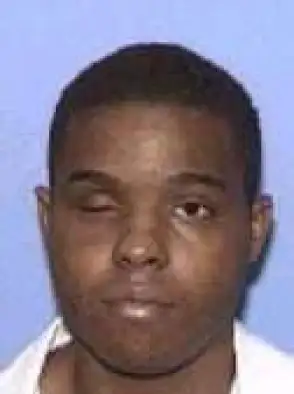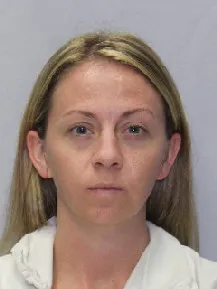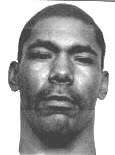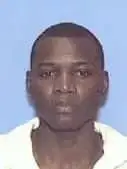Andre Thomas Murders 3 In Texas
Andre Thomas was sentenced to death by the State of Texas for a triple murder
According to court documents Andre Thomas would murder his wife and their two young children: Laura Boren, Andre Jr and Leyha Hughes. Thomas would stab himself three times in the chest
Andre Thomas would be arrested, convicted and sentenced to death
Since being on Texas death row Andre Thomas has plucked out his eyeballs and is believed to have eaten them. Thomas is clearly insane
Andre Thomas Photos
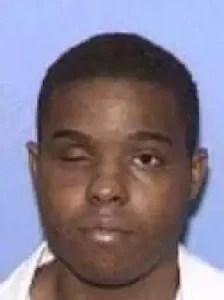
Andre Thomas Now
| Name | Thomas, Andre | |
| TDCJ Number | 999493 | |
| Date of Birth | 03/17/1983 | |
| Date Received | 03/16/2005 | |
| Age (when Received) | 21 | |
| Education Level (Highest Grade Completed) | 09 | |
| Date of Offense | 03/27/2004 | |
| Age (at the time of Offense) | 21 | |
| County | Grayson | |
| Race | Black | |
| Gender | Male | |
| Hair Color | Black | |
| Height (in Feet and Inches) | 5′ 9″ | |
| Weight (in Pounds) | 182 | |
| Eye Color | Brown | |
| Native County | Muskogee | |
| Native State | Oklahoma |
Andre Thomas Case
Justices on the 5th U.S. Circuit Court of Appeals heard arguments in the appeal of one of the area’s most notorious capital murder cases this week. This case is one that hits close to home for many Texomans in a major way.
Andre Thomas was sentenced to death on March 11, 2005 for the death of 13-month-old Leyha Hughes. On March 27, 2004, Thomas fatally stabbed the infant, her mother Laura Boren and Andre Jr., the child Boren shared with Thomas
There was never any doubt that Thomas committed the brutal murders. He confessed to going into the apartment and attempting to remove the hearts of the three victims saying he believed his ex-wife was Jezebel and that little Andre Jr. was the anti-Christ.
While awaiting trial, Thomas pulled out one of his own eyeballs and told medical personnel that he did so after reading a Bible verse about plucking out one’s eye. After he was convicted and sent to death row, Thomas pulled out his other eye and ate it.
The weeks long trial held the front page of local newspapers and the lead spot on the evening news broadcasts.
Then Grayson County District Attorney Joe Brown and his first assistant Kerye Ashmore argued that Thomas deserved to die for the killings that they said he committed while in a psychotic state brought on by his voluntary use of drugs and alcohol. Defense attorneys R.J. Hagood and former Assistant Grayson County District Attorney Bobbie Cate argued that Thomas was insane at the time of the murders
Just a few days past 21-years-old when he was sentenced to death row, Thomas is now 36, blind and housed in the psychiatric ward of the state prison system. His attorneys contend he got there because some of the jurors who determined his fate were prejudiced before the trial started, and the attorneys hired to defend him didn’t do their jobs properly. The state contends that the shocking brutality of the crime and the tender age of the victims played more heavily into the jury’s decision to access the ultimate punishment than Thomas’ race could have.
In the nearly hour-long hearing Wednesday in New Orleans, Thomas’ attorney Catherine Carroll and the state’s attorney, Matthew Frederick, tried to get the three-judge panel to see the record of Thomas’ trial, appeals and the points of law they argued.
The judges could take days or months to make up their minds about the case. If they side with Thomas’ attorneys, the case could be sent back for a trial. If the judges side with the state’s attorneys, Thomas could face many more years of legal battles, and ultimately, an execution date.
“Mr. Thomas’ trial counsel were constitutionally ineffective from start to finish of his capital trial,” Carroll said.
She said she would be addressing the four issues on which the court had granted a certification of appeal. The first was the fact that Thomas’ attorneys took no action when three jurors stated on their questionnaires that they were biased against people who were involved in the type of interracial marriage that Thomas and Boren had
“It is clearly established federal law under the Supreme Court’s decisions. … that a defendant has a right to be tried by an impartial jury and that the presence of even one unbiased juror is structural error that requires reversal without even regard to any prejudice,” she said.
She said the defense attorneys never even bothered to question two of the jurors about their admission to biases based on race. When one of the justices asked if the questionnaire the jurors had to fill out wasn’t a form of questioning them, Carroll said that the questionnaire should have been the red flag that made the defense attorneys stop and dig further.
“It was in their answers to that questionnaire that the jurors admitted, in their own words, that they harbored racial bias,” she said. “And a bias that aligned directly with the facts of this case,” she added.
She said their answers showed that they harbored moral disapproval of Thomas before they even started to consider the crimes for which he was charged.
Additionally, she said that his attorneys failed by not doing enough to explain to the jury why they felt Thomas’ mental state at the time of the murders was due to his life-long mental health struggles and not just to the alcohol and drug abuse he had been partaking in the weeks leading up to the crimes
She said the affidavits that the defense attorneys filed in the appeals of the case say that they didn’t think about bringing up his competency when he was returned from the state mental hospital before the trial. She said they also failed to present an appropriate presentation to the jury of struggles that Thomas had with mental illness throughout his life
She said they also failed to present a complete mitigation case after the jury had convicted Thomas.
“The mitigation case was not simply truncated, or they only saw a portion of the truth, the jury was affirmatively misled by an inaccurate depiction of who Mr. Thomas was as a person and the nature of his illness,” she said.
She added that the investigation that was done during the appeals shows Thomas was not — as jurors were told by the state — a person who had not really had any struggles with his mental health before he started the year of the crime. She said the defense knew that the expert witness they planned to call was not an expert in the kind of drug-induced mental illness that the prosecution claimed caused Thomas to commit the crimes and the state failed to use one of the experts they considered because that expert questioned whether the drugs Thomas could have caused the kind of state he was in when he committed the crimes.
Furthermore, she said, the defense didn’t know enough about Thomas’ mental health background to challenge the state’s expert witness when he testified Thomas had not suffered from mental health issues prior to January of the year the crimes were committed.
Then when they realized they needed someone to counter the state’s expert’s opinion, and received a recommendation of someone who could have done so, they did nothing with that information.
Frederick said there was no Supreme Court opinion that said bias alone creates an incurable inference that the jury can’t be impartial. He said that there was no unequivocal statement by any of the jurors that their ideas about interracial marriages would keep them from being able to be fair in the case.
He said there is a clear statement by the jurors that they thought they could be fair. He said there was nothing in the case that proves that any of the jurors based their decisions in the case on their prejudice against interracial marriage.
As for the competency based claim, Frederick said, Thomas was determined to be incompetent and then examined again some weeks later and determined to be competent. He said Thomas’ claim that the defense should have then objected to that ruling of competency is weak because there was no additional information, or strange action by Thomas, to call his competency back into question. Further he said, on the expert witness claim, there were two ways that the insanity defense could have failed. The first of which was, he said, was a showing of voluntary intoxication and the second would be a showing that Thomas knew his conduct at the time of the crime was wrong.
He said Carroll’s arguments are limited to the voluntary intoxication issue but that leaves “substantial evidence produced at trial that Mr. Thomas did know that his conduct was wrongful at the time,“Frederick said.
He said there was evidence that Thomas had a preexisting mental health condition. The prosecution’s point in the trial, he said, was that Thomas’ voluntary use of drugs and alcohol exacerbated that condition to the point that it caused the state he was in when he committed the crimes.
Further he said, it is true that the defense didn’t interview everyone of Thomas’ family members, but it is also true that Thomas’ mother refused to talk to the defense. They did put on a doctor who testified about the family history and who said that if Thomas had received proper treatment for his mental illness, she didn’t think he would have committed the crimes.
“The case they put on doesn’t leave out any area that Thomas now says should have been examined,” Frederick said. He said the jury heard that Thomas had been diagnosed, in his teens, with mental illness.
He said that there was evidence that possible prejudice against interracial marriage was not the factor that got Thomas convicted. Frederick said the jury foreman testified that once they saw the photographs and crime scene videos the jury had made up its mind not only to convict, but that this was a case that deserved the death penalty.
Since being arrested Andre Thomas has eaten both of his eyes. He has been kept in a Texas Department Of Criminal Justice psychiatric ward for well over a decade
https://www.heralddemocrat.com/news/20200206/15-years-later-andre-thomas-case-back-in-court

